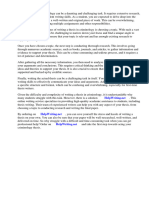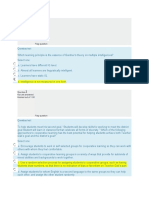The Paper Chase
The Paper Chase
Uploaded by
Michelle WebsterCopyright:
Available Formats
The Paper Chase
The Paper Chase
Uploaded by
Michelle WebsterOriginal Description:
Copyright
Available Formats
Share this document
Did you find this document useful?
Is this content inappropriate?
Copyright:
Available Formats
The Paper Chase
The Paper Chase
Uploaded by
Michelle WebsterCopyright:
Available Formats
In one of the first scenes of the 1973 law school film The Paper Chase, Kingsfield, the imperious
Contract Law professor, informs his newest batch of students that he does not lecture. According to the Professor, students enter with a brain of mush and leave having learned to think like lawyers through intense and relentless questioning. Assuming, as we must, that Kinsfields method is replicated throughout this fictional version of Harvard Law School, there is certainly much to be desired. Kingsfield is a self-proclaimed advocate of the Socratic Method which vigorously involves students in the critical thinking process. Yet the Professors particular version of the Socratic Method lacks the nurturing gentleness that is representative of the actual structure of Socratic dialogue and was indeed characteristic of Socrates himself. Kingsfields viciously antagonistic variation is an overstated caricature of true Socratic Method which need not be so embarrassingly harsh and psychologically abusive. Kingsfield almost appears to be duelling with his students perpetuating an atmosphere of fear and intimidation, all in the name of encouraging preparedness and deep thinking. Hart, the protagonist of the film runs to throw up in a bathroom after his first encounter with the notorious Professor. There are many tales of students going crazy and others simply giving up. One student in the film even went so far as attempting suicide. It is hard to imagine these incidents being the hallmark of a good Law School. Every student has a different way of learning and at no point does Professor Kingsfield take this into consideration, his staunch adherence to his variety of the Socratic Method would hardly allow it. This is not to say that there is absolutely no value in Kingsfields method of teaching, but simply that his particular brand is unnecessarily combative and there are many limits to its efficacy. Effective use of the Socratic Method requires genuine respect for the dialogue process and its participants, a respect which the learned professor failed to exhibit. It is essential that law professors be aware that new students are likely not practiced in the skill of public speaking. Public denigration of a student can be destructive to the psyche, while intense verbal duelling may at times work contrary to genuine understanding. When used properly the Socratic Method can be a powerful learning tool. Its focus on participatory learning and the advancement of discourse is well suited for teaching a discipline such as Law, where the goal is to learn how to analyse legal problems and think critically. The law is in a continuous state of change and the problems confronting the lawyers of today will most likely differ from that faced by the lawyers of tomorrow, consequently the development of reasoning skills that can be applied regardless of the question, is of paramount importance. Nevertheless, the Socratic Method alone is hardly sufficient to properly prepare law students for practice. The focus on legal theory does little to develop necessary practical skills such as proper client-counsel interaction. Additionally there is much to be said for traditional lecture based teaching which provides students with a basic understanding of key concepts from which they can then develop, through the use of the Socratic Method. One need not look very far to see the value of supplementation. The Practice of combining tutorials (which are generally more in keeping with the Socratic Method) with traditional lectures have proven quite successful for Norman Manley Law School which recently beat out Harvard Law School at the World Human Rights Moot Competition in South Africa.
Although Professor Kingsfields focus on reasoning by analogy and critical thinking has many positive aspect his intense and unyielding severity adds nothing to his method. What is more the Socratic method alone without supplementation
You might also like
- Shifting DirectionDocument4 pagesShifting DirectionMichelle Webster75% (4)
- Part G Mathematics Assessment CommentaryDocument7 pagesPart G Mathematics Assessment Commentaryapi-453481434No ratings yet
- Persuasive Essay - Revised Doc-Liberal Arts EducationDocument13 pagesPersuasive Essay - Revised Doc-Liberal Arts Educationapi-253726524No ratings yet
- Case Study Essay ExampleDocument8 pagesCase Study Essay Examplebmakkoaeg100% (2)
- Barrett Thesis IdeasDocument4 pagesBarrett Thesis IdeasLisa Graves100% (1)
- The Socratic Method Reloaded: How To Make It Work in Large Classes?Document9 pagesThe Socratic Method Reloaded: How To Make It Work in Large Classes?tripathisoumya532No ratings yet
- Thesis Title For Criminology StudentDocument4 pagesThesis Title For Criminology Studenttsivhqvcf100% (2)
- Thesis Statement Role Model EssayDocument6 pagesThesis Statement Role Model Essayhptfbggig100% (2)
- Riffel - The Socratic Method ReloadedDocument11 pagesRiffel - The Socratic Method ReloadedJohir MuhammadNo ratings yet
- Teacher Thesis TopicsDocument8 pagesTeacher Thesis Topicswfwpbjvff100% (2)
- Thesis Topics in School ProblemsDocument8 pagesThesis Topics in School Problemsdwsmjsqy100% (2)
- Ed.d Dissertation TopicsDocument6 pagesEd.d Dissertation TopicsWhatAreTheBestPaperWritingServicesCanada100% (1)
- 100 Best Thesis TopicsDocument7 pages100 Best Thesis TopicsNeedHelpWriteMyPaperSingaporeNo ratings yet
- The Socratic Method in The 21st CenturyDocument6 pagesThe Socratic Method in The 21st Centurymatthew_mcmillionNo ratings yet
- Masters Thesis Topics in PsychologyDocument5 pagesMasters Thesis Topics in Psychologygjdpj4jq100% (1)
- Most Common Thesis TopicsDocument8 pagesMost Common Thesis TopicsMonique Carr100% (2)
- Good Topics To Write A Thesis OnDocument5 pagesGood Topics To Write A Thesis Onalisonreedphoenix100% (2)
- Movie Thesis TopicsDocument7 pagesMovie Thesis Topicstonyarobertsknoxville100% (2)
- Research Dissertation TopicsDocument6 pagesResearch Dissertation TopicsPayToDoMyPaperSingapore100% (1)
- Essay Topics ThesisDocument6 pagesEssay Topics ThesisTony Lisko100% (1)
- PHD Thesis Sociology TopicsDocument7 pagesPHD Thesis Sociology TopicsPayingSomeoneToWriteAPaperLowell100% (2)
- Thesis Topic IdeasDocument8 pagesThesis Topic Ideastonyacartererie100% (2)
- Thesis Topics in SociologyDocument7 pagesThesis Topics in Sociologywhitneyturnerlittlerock100% (2)
- Synthesis Essay On Standardized TestingDocument4 pagesSynthesis Essay On Standardized Testingtracyjimenezstamford100% (1)
- Sample Dissertation SociologyDocument7 pagesSample Dissertation SociologyApaPapersForSaleSingapore100% (1)
- 66 436 1 PBDocument4 pages66 436 1 PBfruitfulscionNo ratings yet
- Thesis Topics For 4th YearDocument4 pagesThesis Topics For 4th Yearexuhszief100% (2)
- Writing SampleDocument2 pagesWriting SampleAngie JosolNo ratings yet
- Socratic MethodDocument2 pagesSocratic MethodAnonymous KRQaT2PnYqNo ratings yet
- Argumentative Essay Against Gay MarriageDocument3 pagesArgumentative Essay Against Gay Marriageafibajhehlvncv100% (2)
- Undergraduate Dissertation Examples CriminologyDocument8 pagesUndergraduate Dissertation Examples CriminologyOrderCustomPapersUKNo ratings yet
- Socratic Method ReportDocument7 pagesSocratic Method ReportDumsteyNo ratings yet
- Autoethnography Dissertation ProposalDocument4 pagesAutoethnography Dissertation ProposalPaperWriterAtlanta100% (1)
- Thesis Topic Ideas For EducationDocument5 pagesThesis Topic Ideas For EducationWriteMyPaperCollegeWichitaFalls100% (2)
- Thesis Topics in Social PsychologyDocument4 pagesThesis Topics in Social PsychologyErica Thompson100% (2)
- Easy Thesis Topics PsychologyDocument7 pagesEasy Thesis Topics PsychologySheila Sinclair100% (1)
- Thesis Topics in Education ListDocument7 pagesThesis Topics in Education Listgcqbyfdj100% (2)
- "Keeping It Real For Teaching Demonstrations and Case Scenarios" - HigherEdJobsDocument3 pages"Keeping It Real For Teaching Demonstrations and Case Scenarios" - HigherEdJobsozergyalmoNo ratings yet
- Good PHD Thesis TopicsDocument7 pagesGood PHD Thesis Topicsgbx272pg100% (2)
- Choosing A Dissertation Topic UkDocument7 pagesChoosing A Dissertation Topic UkWebsitesToTypePapersSingapore100% (1)
- Top 100 Thesis TopicsDocument8 pagesTop 100 Thesis Topicsnikkismithmilwaukee100% (1)
- Sample Thesis Title For Criminology StudentsDocument5 pagesSample Thesis Title For Criminology StudentsPaperWritingServicesReviewsUK100% (2)
- Zero Tolerance DissertationDocument5 pagesZero Tolerance DissertationPayToWritePapersUK100% (1)
- Dissertation Topics English StudiesDocument5 pagesDissertation Topics English StudiesWriteMyPaperOneDaySingapore100% (1)
- High School Thesis Topics PhilippinesDocument7 pagesHigh School Thesis Topics Philippineswcldtexff100% (2)
- Cool Thesis TopicsDocument7 pagesCool Thesis Topicsdwg1pv0n100% (2)
- Education Thesis Topics ListDocument6 pagesEducation Thesis Topics Listlizhernandezalbuquerque100% (2)
- Are Law Schools Preparing Students For Real Life CareersDocument3 pagesAre Law Schools Preparing Students For Real Life Careersaaditya moothaNo ratings yet
- University Level Thesis ExampleDocument8 pagesUniversity Level Thesis Examplefjbnd9fq100% (2)
- Possible Thesis Topics in SociologyDocument6 pagesPossible Thesis Topics in Sociologyshannonolsenomaha100% (1)
- Undergraduate Criminology Dissertation ExamplesDocument7 pagesUndergraduate Criminology Dissertation ExamplesCustomThesisPapersSingaporeNo ratings yet
- Term Paper CriminologyDocument7 pagesTerm Paper Criminologyafmzzgidncysun100% (1)
- Thesis Statement Examples For Social MediaDocument5 pagesThesis Statement Examples For Social Mediawyppfyhef100% (2)
- Criminology Thesis Title List in The PhilippinesDocument8 pagesCriminology Thesis Title List in The PhilippinesBuyAPaperOnlineSingapore100% (2)
- Gerez - Enabling StrategiesDocument3 pagesGerez - Enabling StrategiesAljo Cabos Gaw100% (1)
- Mphil Thesis in Computer ScienceDocument6 pagesMphil Thesis in Computer Sciencekellylindemannmadison100% (2)
- Find Thesis DesignerDocument4 pagesFind Thesis DesignerBuyPapersForCollegeCanada100% (2)
- 12 Legal Ethics 35Document25 pages12 Legal Ethics 35First_LastNo ratings yet
- What Are Some Good Dissertation TopicsDocument5 pagesWhat Are Some Good Dissertation TopicsCanIPaySomeoneToWriteMyPaperUK100% (1)
- The Magdalene SistersDocument6 pagesThe Magdalene SistersMichelle Webster0% (1)
- Distress BdosDocument7 pagesDistress BdosMichelle Webster100% (1)
- There's Something About Mary-JaneDocument5 pagesThere's Something About Mary-JaneMichelle WebsterNo ratings yet
- There Is No "E" in Zombi Which Means There Can Be No You or WeDocument3 pagesThere Is No "E" in Zombi Which Means There Can Be No You or WeMichelle WebsterNo ratings yet
- Eleusis: 1 EquipmentDocument5 pagesEleusis: 1 EquipmentMichelle WebsterNo ratings yet
- Better Chickens Statement of ClaimDocument3 pagesBetter Chickens Statement of ClaimMichelle WebsterNo ratings yet
- Simon and Molly Plus Hester Lesson PlanDocument7 pagesSimon and Molly Plus Hester Lesson Planapi-300269240No ratings yet
- Research Core LectureDocument71 pagesResearch Core LectureAdzNo ratings yet
- Cognitive ControlDocument2 pagesCognitive ControlbobnhNo ratings yet
- Electric Play Dough Science Lesson PlanDocument2 pagesElectric Play Dough Science Lesson Planapi-311427576No ratings yet
- Session Guide PedagogyDocument3 pagesSession Guide PedagogyJOHN PAUL TIGUENo ratings yet
- Lesson 2 - Bibliography Lesson PlanDocument4 pagesLesson 2 - Bibliography Lesson Planapi-377735455No ratings yet
- Plato, Aristotle, DescartesDocument3 pagesPlato, Aristotle, DescartesZsazsa100% (1)
- The Socratic Method As An Approach To Learning and Its BenefitsDocument51 pagesThe Socratic Method As An Approach To Learning and Its BenefitsoussNo ratings yet
- Integrated Unit Plan Day OneDocument4 pagesIntegrated Unit Plan Day Oneapi-322101445No ratings yet
- Doug Sigel, Northwestern University "Punishment: Does It Fit The Crime? 1985Document3 pagesDoug Sigel, Northwestern University "Punishment: Does It Fit The Crime? 1985Jack WilsonNo ratings yet
- Rosemarie Parse PDFDocument4 pagesRosemarie Parse PDF李思雨No ratings yet
- Journal of Scientific Exploration (OBE)Document220 pagesJournal of Scientific Exploration (OBE)minimike87No ratings yet
- Conversation by HooksDocument1 pageConversation by Hooksapi-289607619No ratings yet
- Learning and DevelopmentDocument17 pagesLearning and Developmentsudhirreddychadipirala100% (2)
- Mount Carmel College of Escalante, Inc.: Carmelite Street, Escalante City, Negros Occidental College DepartmentDocument4 pagesMount Carmel College of Escalante, Inc.: Carmelite Street, Escalante City, Negros Occidental College DepartmentKimberly ArdoNo ratings yet
- Interdisciplinary Science ProjectDocument23 pagesInterdisciplinary Science Projectapi-353398451No ratings yet
- Edtpa Ele Math Assessment Commentary FinalDocument5 pagesEdtpa Ele Math Assessment Commentary Finalapi-270873656No ratings yet
- Research Interest FormatDocument2 pagesResearch Interest Formataz_asharNo ratings yet
- Othello Essay AssignmentDocument2 pagesOthello Essay AssignmentSherry R. Blanton KeownNo ratings yet
- Function of PhilosophyDocument18 pagesFunction of PhilosophyFranklin100% (1)
- 620 Lesson PlanDocument4 pages620 Lesson Planapi-387557660No ratings yet
- Answer Saved Marked Out of 1.00Document5 pagesAnswer Saved Marked Out of 1.00Onem100% (1)
- Educ 5312-Research Recep BatarDocument6 pagesEduc 5312-Research Recep Batarapi-290710546No ratings yet
- Composition II s3Document2 pagesComposition II s3kaoutarNo ratings yet
- Eapp Lesson Building A Position - 2nd QuarterDocument14 pagesEapp Lesson Building A Position - 2nd QuarterRizli BatiancilaNo ratings yet
- Instructional Planning: Learning Competency/Ies: Code: Cs - Rs11-Iiib-1Document6 pagesInstructional Planning: Learning Competency/Ies: Code: Cs - Rs11-Iiib-1Adrian Reyes Capalar100% (1)
- Managing KnowledgeDocument52 pagesManaging Knowledgefahmionly1303No ratings yet
- First Language Acquisition: Psychological Considerations and EpistemologyDocument6 pagesFirst Language Acquisition: Psychological Considerations and EpistemologyMimi FarahNo ratings yet
- Q.NO.1) What Is The Difference Between Management and Administration?Document6 pagesQ.NO.1) What Is The Difference Between Management and Administration?तोइच मोइचNo ratings yet
































































































